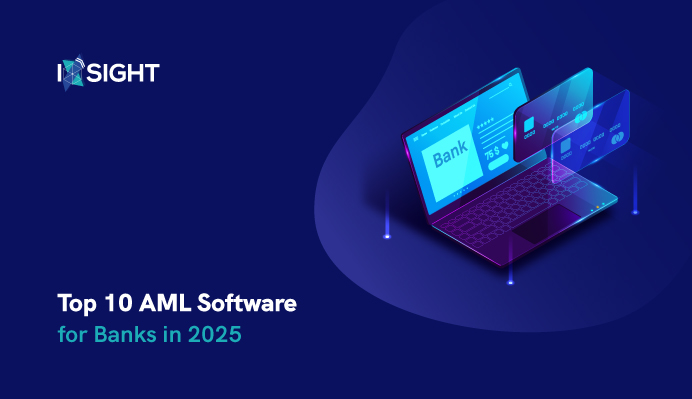Ixsight is looking for passionate individuals to join our team. Learn more

Ixsight is looking for passionate individuals to join our team. Learn more


AML software is a loyal sentry in the hectic environment of the banking industry, where money transactions are like rivers and financial crimes are living in the shadow. Banks are under increasing pressure to both follow strict rules and prevent advanced money laundering operations. The issue is that the right AML software not only keeps your business compliant but also strengthens trust and operational efficiency. This paper will look at the meaning of AML in the banking context, the revolutionary value of AML software, the key capabilities that characterize the best solutions, and a hand-picked list of the 10 best AML software for banks in 2025. Find out which AML software to choose to fit your bank and how these technological solutions can carve a safe financial future.
The concept of Anti-Money Laundering (AML) in banking implies a sound package of policies, procedures, and technologies that aid financial institutions in detecting and reporting any suspicious transactions that help criminals conceal ill-gotten gains as lawful revenues. Financial institutions implement AML to identify and report suspicious transactions to achieve regulatory compliance on an international level (such as the Financial Action Task Force (FATF)) and national levels (such as the U.S. Bank Secrecy Act (BSA). Banking AML is a safeguard against financial crime, including fraud, terrorist financing, and drug trafficking. Using enhanced AML software, banks have become proactive in screening transactions, identifying customers, and keeping excellent records to ensure they are ahead of the regulatory examinations and safeguard their reputation. This preventative strategy makes AML in banking one of the pillars of financial integrity.
The AML software offers groundbreaking benefits that enable banks to tackle the tricky environment of financial compliance.
AML software is powerful because of its complex functionality, and each feature is designed to address the versatile nature of financial crime. The real-time transaction monitoring examines all financial transactions and reports abnormalities immediately, so that money laundering is thwarted before it establishes itself. The tools of customer due diligence (CDD) and Know Your Customer (KYC) authenticate identities and prepare risk profiles, thus making sure that the banks only onboard legitimate customers.
Sanctions and Politically Exposed Persons (PEP) screening cross-references customers against world watchlists, barring high-risk parties. Another level of screening is done through adverse media screening, which searches online sources to find negative coverage. Powerful sanction screening software ensures that these checks are comprehensive and up to date. Such an essential feature as deduplication removes all the duplicating data, leaving only clean and accurate datasets to run risk assessments. Case management systems facilitate the investigation process, and automated reporting can make Suspicious Activity Reports (SARs) and Currency Transaction Reports (CTRs) without any problems. All these characteristics strengthen AML software, turning it into a compliance and security powerhouse.
Innovation, scalability, and compliance expertise are required in the search for the appropriate AML software. Without further ado, below we reveal the leading 10 AML software solutions for banks in 2025, each of which has performed well in terms of offering powerful functionality to fight financial crime.
SymphonyAI is the AI-powered AML software provider used by the leading banks worldwide. Its Sensa Copilot generative AI assistant reduces manual review by 30 percent, improving the efficiency of investigators. Screening of transactions in real-time against 350+ global watchlists and 60 languages covers all grounds. Deduplication features of SymphonyAI will clean up the accuracy of the data, and its powerful case management will facilitate investigations.
NICE Actimize provides a complete range of AML solutions to more than 250 banks globally. Its transaction monitoring and real-time fraud prevention identify suspicious patterns accurately. AI-based risk scoring and behavioral analytics enable the software to eliminate false positives, and deduplication makes the data clean to provide accurate reporting. NICE Actimize would be ideal in cases where banks require scalable, cross-channel AML software to address payment fraud and sanctions screening
ComplyAdvantage is the star when it comes to digital and mid-market banks and AI-powered risk detection. Its transaction monitoring and negative media screening apply machine learning to reveal the obscure risks. Deduplication will remove unnecessary alerts, improving efficiency. This AML software is a good fit if your bank values configurability of the data feed and ease of API integration, as well as real-time compliance and scalability.
LexisNexis Bridger Insight is a powerful KYC and sanctions screening tool, using full access to worldwide databases. Its real-time monitoring capability and deduplication capability will lead to accurate risk assessment, and automated reporting will ease compliance. This AML software becomes a solution of choice when it comes to banks that need profound data analytics and regulatory compliance across different jurisdictions.
The Oracle AML software is a flexible AML solution combined with powerful analytics that provides transaction monitoring, risk scoring, and automatic reporting. Its deduplication features prepare data to be clean and accurate in investigation processes, and its cloud-scale ensures expanding banks. Oracle would perfectly suit institutions that want customizable AML software, which can be integrated with the existing systems.
SAS equips banks with AI-enabled and superior analytics AML software. It's time that transaction monitoring and behavioral profiling identify complicated laundering schemes. Deduplication guarantees the integrity of data, and automated case management boosts the speed of investigation. SAS can be applied to banks with a large number of transactions that want to have predictive capabilities.
Napier AI is a RegTech company based in the UK and provides a modular AML compliance platform. Its smart compliance platform allows real-time screening, risk analysis, and deduplication to minimize false positives. The AML software provided by Napier is ideal in case of banks that require scalable, flexible solutions in order to address the various global regulatory requirements.
The AML software by Quantexa uses graph analytics and AI to reveal customer network risks that are hidden. Its deduplication and transaction monitoring capabilities make it accurate in risk detection, and the case management makes investigation easy. Quantexa would perfectly suit banks looking to use intelligence data to comply with regulations.
The AML software provided by Lucinity focuses on intelligent case management and user-friendly compliance. Its real-time monitoring and deduplication features help to cut down on manual processes, and behavioral analytics help identify suspicious patterns. This AML software is applicable to banks that want user-friendly interfaces and effective operations.
Fiserv provides strategic AML software that has risk management built in. Its transaction monitoring, sanctions screening, and deduplication capabilities make it channel compliant. The AML software offered by Fiserv is specialized to serve banks that require end-to-end solutions to keep up with the ever-changing financial crimes.
The selection of the appropriate AML software depends on the particular needs of your bank, its size, and the scope of operations. SymphonyAI or NICE Actimize could be the preferred choice of large global banks looking to use the power of AI and scale their high-complexity, high-volume transactions. ComplyAdvantage or Lucinity could be chosen as they are user-friendly and can be operated in real-time, which might be preferred by mid-market or digital banks. The most important factors to consider are its integration with other systems, the ability to help with multi-jurisdictional compliance, and effective deduplication to limit the amount of data redundancy. Budget also plays a massive role here, whereby solutions such as Vespia provide a cheap tiered subscription model, high-end solutions such as Oracle give comprehensive tools but at a premium price. Consider scalability, customer support, and AI-powered capabilities so that your AML software can comply with your compliance strategy and development plans.
AML software is changing the way banking is conducted by making labor-intensive processes automated and improving decisions. This is because real-time transaction monitoring can detect suspicious activities, thereby narrowing the opportunity for financial crimes. Deduplication software will result in clean data, which will allow proper risk assessment and minimize false positives. Computerized reporting can simplify the process of compliance with such regulations as the BSA and FATF, reducing manual error. The AML software allows viewing the full picture of customer activity by integrating with CRM systems and third-party databases, thereby improving decisions made by banks. Such efficiency not only leads to cost reduction but also allows compliance teams to spend more time working on high-value investigations, enhancing the overall security of the bank.

AML software is evolving and becoming smarter and more adaptive with the help of artificial intelligence and machine learning. Machine learning risk scoring can analyze large volumes of data to identify obscure patterns of financial crime, and is much faster than the rule-based systems of the past. New data causes the machine learning models to adapt and identify new laundering methods, such as crypto-based laundering schemes or mule accounts. AI-enabled deduplication improves the quality of datasets by removing redundancies, making the analysis accurate. By cutting false positives and improving alert prioritization and speeding up investigations, these technologies make AML software an agile tool to help banks in 2025.
Even though the benefits of AML software are enormous, implementation may be a challenge. Legacy system integration can be hectic, and it may need IT experts to make sure that there is smooth interconnectivity. Up-front expenses, particularly of higher-end products such as SAS or Oracle, can be a budget stretch, but this is mitigated by long-run cost savings in fines and manual effort. Training of the staff is necessary so as to make the most out of the software, especially in functions such as deduplication and case management. Also, the ability to meet the changing regulations across different jurisdictions requires flexible, scalable AML software. The hurdles can be overcome by selecting a vendor that has solid customer support and frequent updates; therefore, adoption is not problematic.
Technological innovation and regulatory evolution are the two factors that make the future of AML software bright. The application of blockchain is becoming increasingly popular, with clear tracking of transactions able to stop crypto-related laundering. Collaborative systems. Banks can share anonymized data through collaborative systems, such as federated learning offered by Tookitaki, to improve AML models on an industry-wide basis. Intuitive interfaces that allow dashboard customization are forming the norm, which enhances efficiency in compliance teams. Improved deduplication algorithms will also narrow down the data accuracy, eliminating false positives. With regulations, such as the EU 6th AML Directive becoming stricter, AML software will focus on multi-jurisdictional compliance, keeping banks ahead of the game in 2025 and beyond.
By the year 2025, AML software will not supplement the work of banks, but it is an absolute must-have in a highly complicated environment of regulations and crimes. Failure to comply carries the risk of heavy penalties, with the example by the Deutsche Bank, which was fined 630 million USD in 2017 due to AML lapses. Other than preventing fines, AML software safeguards customer trust and brand image, which is valuable in a competitive environment. AML software can enable banks to work safely and effectively by automating compliance, minimizing false positives, and utilizing deduplication and other features. Investment in appropriate AML software is an investment in the resilience of banks to be compliant, competitive, and trusted in the continuously changing financial world.
Also read: What Are the Four Pillars of AML?
AML software is a critical necessity for banks in 2025, not just for regulatory compliance but also for strengthening operational efficiency, safeguarding reputation, and combating evolving financial crimes. With AI, machine learning, and advanced features like deduplication and real-time monitoring, modern AML solutions offer banks the agility and precision needed in today’s dynamic threat landscape. Choosing the right AML software ensures long-term resilience, trust, and competitiveness.
To support organizations in maintaining compliance and data integrity, Ixsight offers Deduplication Software, Sanctions Screening Software, Data Cleaning Software, and Negative Data Scrub Software. These solutions help businesses streamline data management, detect anomalies, and ensure accurate customer verification, ultimately strengthening KYC and AML processes.
Our team is ready to help you 24×7. Get in touch with us now!